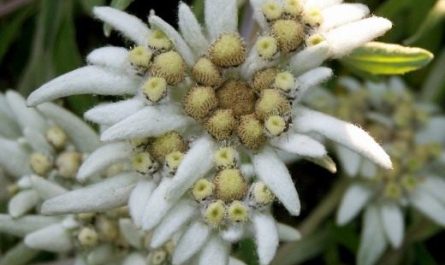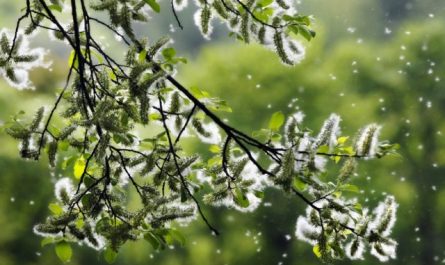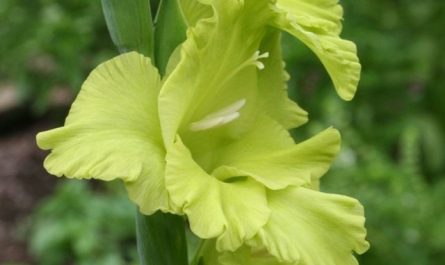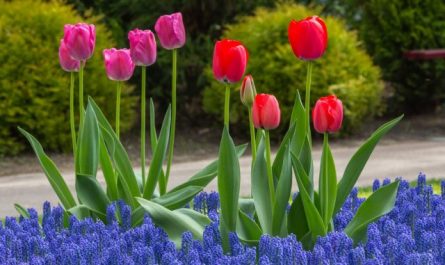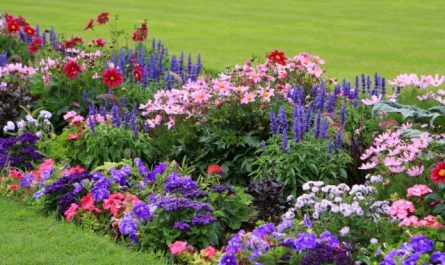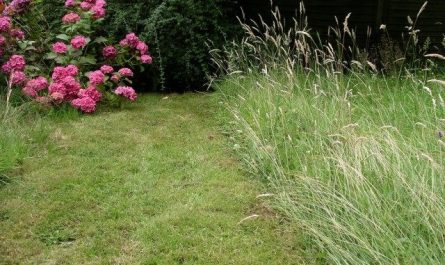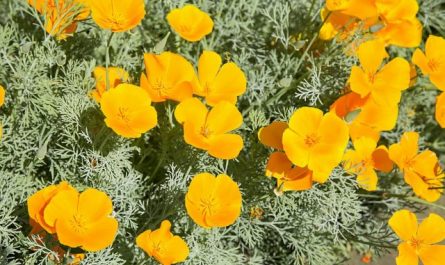The first definition that comes to mind when you hear the word “garden” is blooming. Many gardeners strive to plant the maximum number of beautifully blooming perennials, annuals and shrubs on their plot, forgetting that it is not only lush inflorescences that make plant compositions spectacular. Today we will talk about how to create a bright composition in the garden using variegated plants.
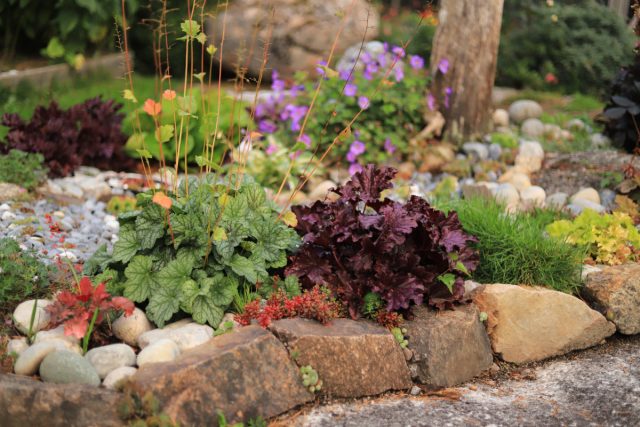
Plants with unusual foliage even win over their flowering competitors, since their decorativeness does not depend on the flowering period. This makes it possible to create compositions that are invariably attractive throughout the season. They can be either colored (various shades of red, yellow and blue) or variegated, i.e. having a contrasting border, strokes or spots. Let’s take a closer look at the most popular perennials in landscape design.
Hosts
The diversity of hostas is truly amazing. If desired, you can even create a beautiful flowerbed of only hostas – hostarium. But, as a rule, hostas are planted in mixed compositions, where their decorative foliage harmonizes well with both flowering and decorative foliage plants.
Almost all hostas are shade-tolerant (except for yellow-leaved cultivars of the hybrid hosta), unpretentious, but prefer moderately moist, nutritious, drained loams with earthworms. They have high winter hardiness (except for the plantain hosta and its varieties), and are rarely affected by diseases and pests. They can grow in one place for a very long time. An important advantage is the distinct hemispherical shape of the bush.
They bloom from June to August with paniculate inflorescences; in decorative foliage compositions they can be cut.
“Antiochus”
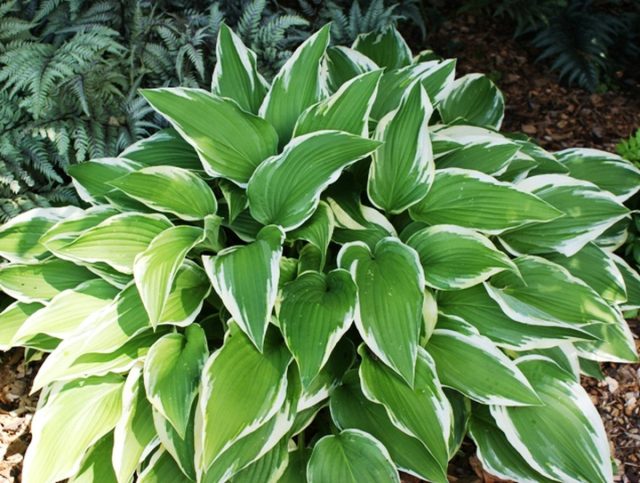
A fast-growing variety of Hosta ‘Antioch’, 55 cm tall, with broad green heart-shaped leaves with a creamy-white, later pure-white border. Blooms in July-August with pale lavender inflorescences. Prefers shade/partial shade.
“Brim Cap”
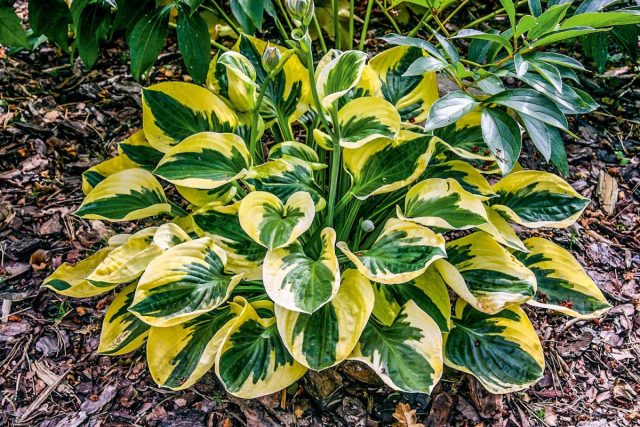
The popular variety ‘Brim Cup’ (Hosta ‘Brim Cup’) is medium in size: 30-35 cm, with cup-shaped textured green leaves with a wide yellow border. Blooms in June-June with light blue flowers changing to white. Planting location – shade/partial shade.
“Fireworks”
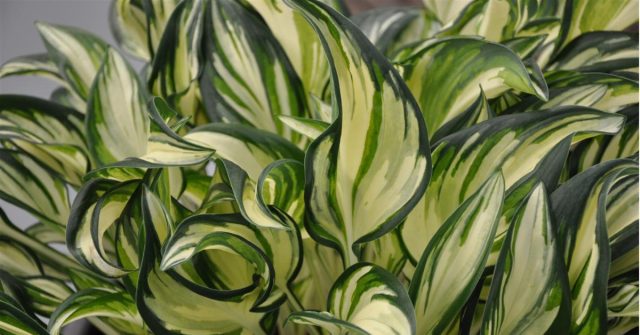
A spectacular medium-sized variety, ‘Fireworks’ (Hosta ‘Fireworks’), up to 35 cm high, with narrow, wavy white leaves with a thin green border. It blooms with lavender inflorescences in July. Needs shading.
“June Fever”
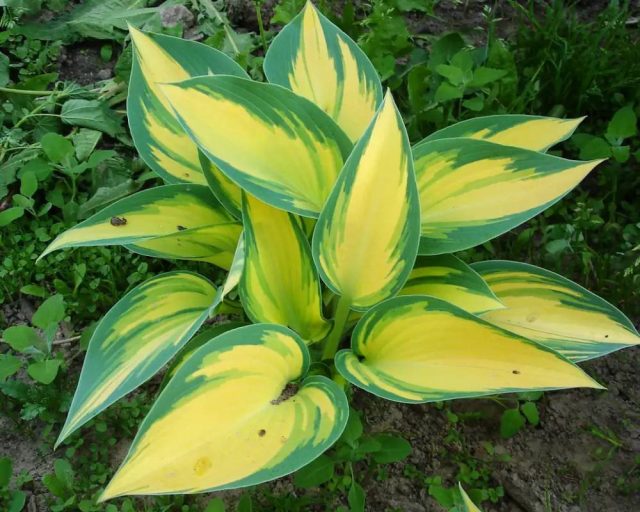
Hosta ‘June Fever’ is a plant up to 45 cm tall with bright yellow foliage and a narrow greenish-blue edge. Lavender flowers can be seen in July. Can be grown in full sun.
“Fragrant Blue”
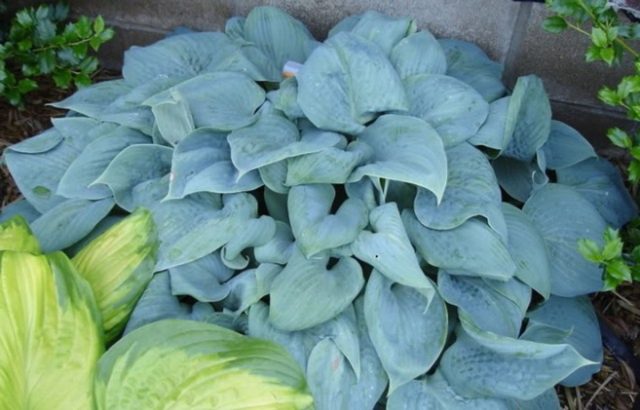
Medium-sized variety “Fragrant Blue” (Hosta ‘Fragrant Blue’) up to 45 cm high. Leaves with pronounced veins and a powerful waxy coating, which gives them a green-blue tint. The border is thin white. White flowers with a light aroma bloom in July-August. Prefers shade/partial shade.
“Prairie Sky”
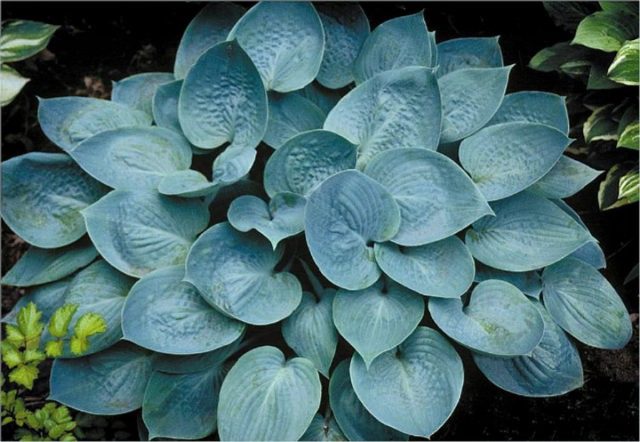
Hosta ‘Preirie Sky’ is another blue variety with rounded, slightly cupped leaves without a border. Height – up to 45 cm. Blooms with lavender flowers in June-July. Grows best in shade/partial shade.
“Earth Angel”
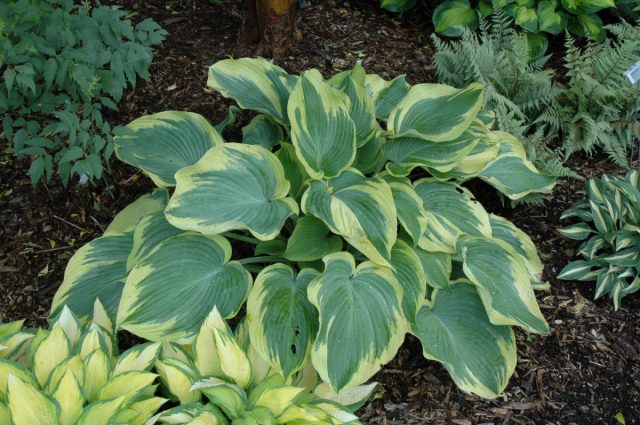
A large variety of Hosta ‘Earth Angel’, up to 90 cm high. Heart-shaped leaves, bluish-green, very large, with an uneven border changing from cream to white. Blooms with pale lavender panicles in June-July. Prefers shade.
“Island Charm”
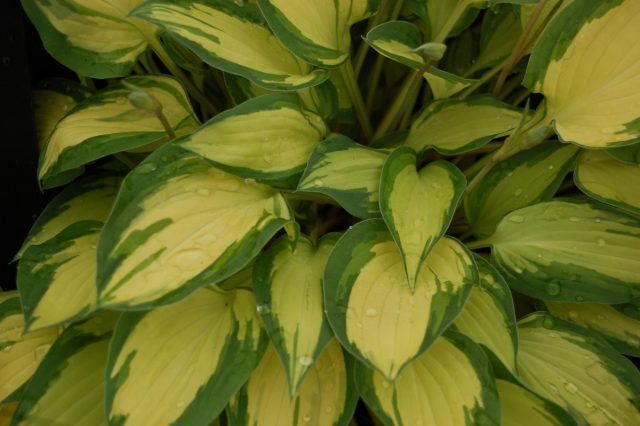
A compact, low-growing variety, ‘Island Charm’ (Hosta ‘Island Charm’) is 15-20 cm tall. The foliage changes shade from yellow to creamy white and has an uneven green border. Blooms in July with lavender flowers. Light partial shade is ideal.
Lungworts (Pulmonaria)
In landscape design, lungworts are used: sugar, narrow-leaved, long-leaved, medicinal, and hybrid. Sugar and medicinal are widespread in natural forests of the middle zone. All lungworts are shade-tolerant, but can also grow in sunny areas. Lungwort is valued not only for its amazing foliage, but also for its early flowering (in April-May).
Soil requirements vary: sugar lungwort needs loose, moist, humus-rich soils, long-leaved lungwort is undemanding and can grow on any soil, and narrow-leaved lungwort prefers poor, dry soils. Lungwort is a very important plant for natural-style flower beds and shady areas.
Lungwort has long lanceolate leaves, which are denser than other lungworts, so it grows well in the sun.
“Bertram Anderson”
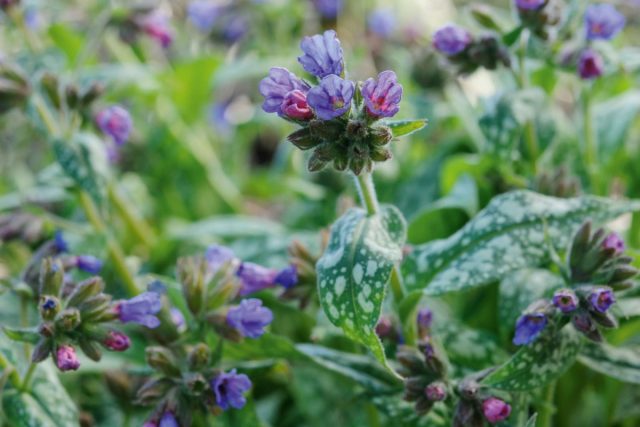
The cultivar ‘Bertram Anderson’ (Pulmonaria longifolia ‘Bertram Anderson’) has long, narrow dark green leaves with lots of white spots and bright blue flowers that bloom in April. The flowering height is 25-30 cm.
“Diana Claire”
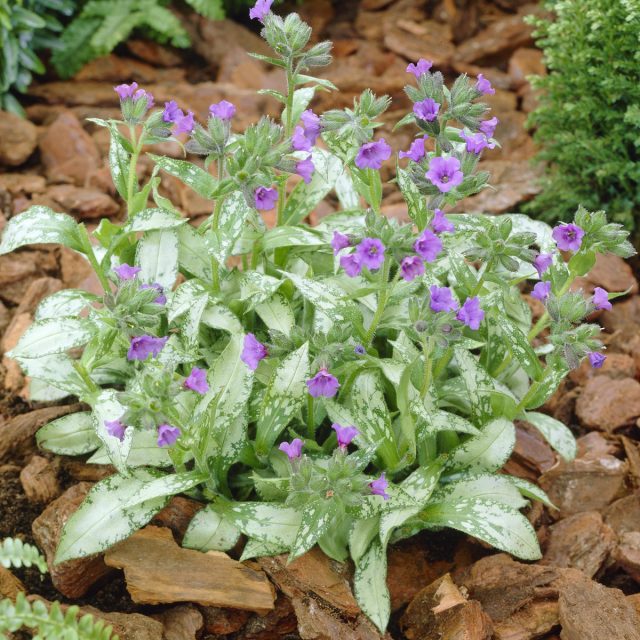
Pulmonaria longifolia ‘Diana Claire’ reaches 30-40 cm in flowering and has lanceolate foliage, dark green with silvery spots on top and grey underneath, eventually becoming completely silvery and pubescent. It blooms in April-May with large blue-violet funnel-shaped flowers.
“Dora Bielefeld”
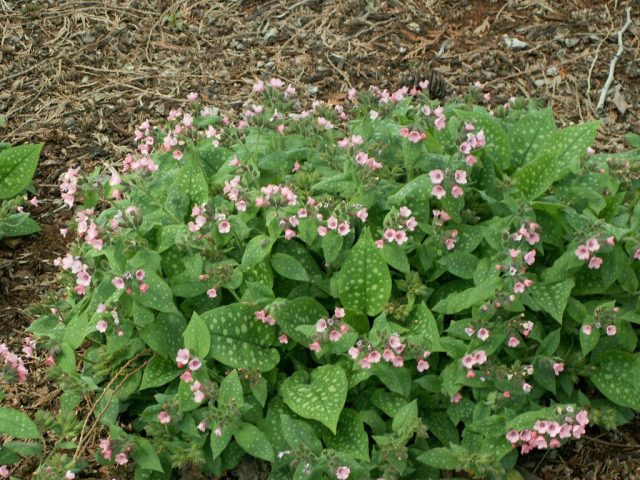
Sugar lungwort is capable of forming a dense ground cover 15-30 cm high, the foliage is evergreen and appears after flowering. It is included in the unofficial top plants for the foreground of a flower bed. Many cultivars have been bred.
The variety of sugar lungwort “Dora Bielefeld” (Pulmonaria saccharata ‘Dora Bielefeld’) has more rounded bright green leaves with light gray, sometimes almost solid spots. In flowering it reaches 30 cm. It blooms pink in April-May.
“Leopard”
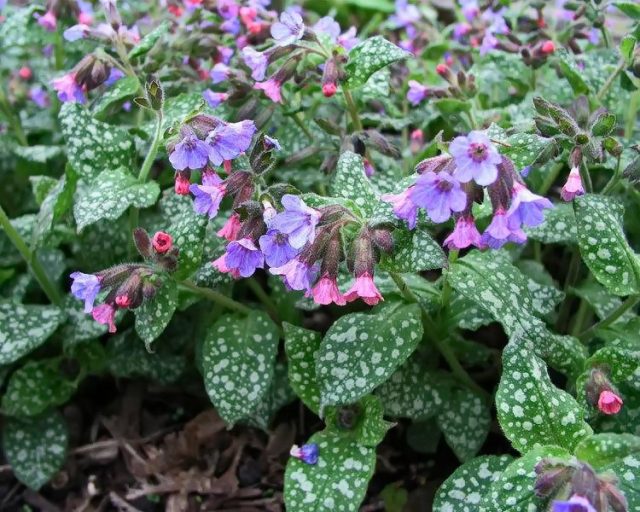
The variety of sugar lungwort ‘Leopard’ (Pulmonaria saccharata ‘Leopard’) has dark green foliage with numerous rounded silver spots. The flowers are red with a pink tint, blooming in April. The height in flowering is 30 cm.
“Samurai”
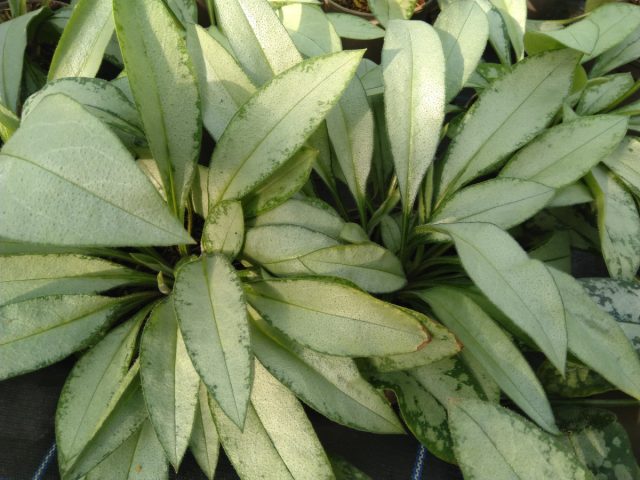
Hybrid lungwort combines varieties obtained with the participation of different types of lungwort.
The variety of lungwort “Samurai” (Pulmonaria ‘Samurai’) has narrow lanceolate completely silvery leaves. Large purple flowers adorn the plant in April-May. The height in flowering is 30 cm.
“Opal”
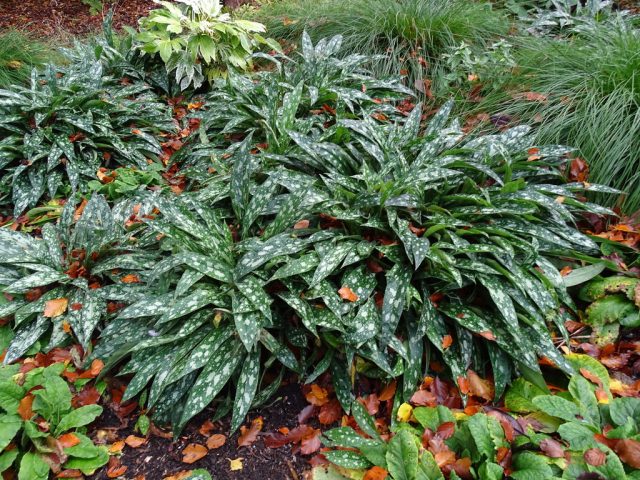
Unusual for lungworts in general is the variety “Opal” (Pulmonaria ‘Opal’): its flowers are almost white. They bloom in April-May. During this period, the plant reaches 30 cm. The leaves are pointed, pubescent, green with silvery-white splashes and spots.
Athyrium
In terms of the diversity of species and forms, all kinds of ferns will give odds to any representative of the plant world. All ferns are distinguished by amazingly graceful jagged leaves, decorative only by their texture, as well as an exquisite habit.
Ferns are irreplaceable in mixborders in the style of a “natural garden” and for landscaping shady corners of the garden. In design, shield ferns, lady’s foot ferns, multi-rowed ferns, common ostrich ferns, osmundas and many others are widely used. However, the variegated forms that interest us are found mainly in the Nippon lady’s foot fern.
Lady ferns prefer shade or partial shade. In the sun, lady ferns even lose size and turn pale. They love drained, moist, fertile soils, but are generally unpretentious. They can grow in one place for up to 15 years. They are winter-hardy.
Nippon fern looks its best in spring with its brownish-purple fronds.
“Red Beauty”
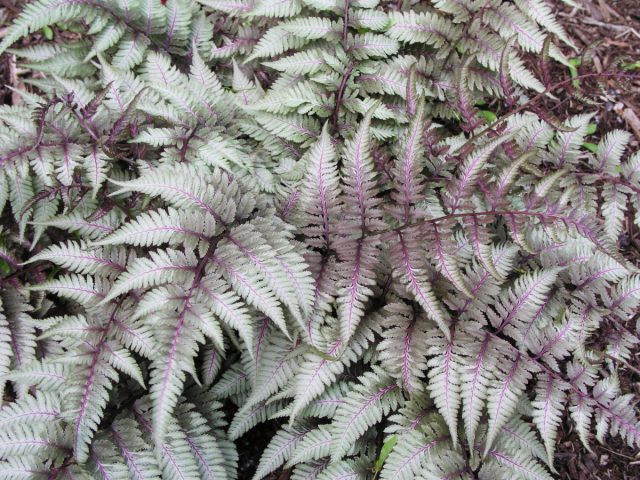
Athyrium niponicum ‘Red Beauty’ has green-silver leaves with contrasting burgundy stems and veins. It reaches 55-60 cm in height.
“Ursula’s Red”
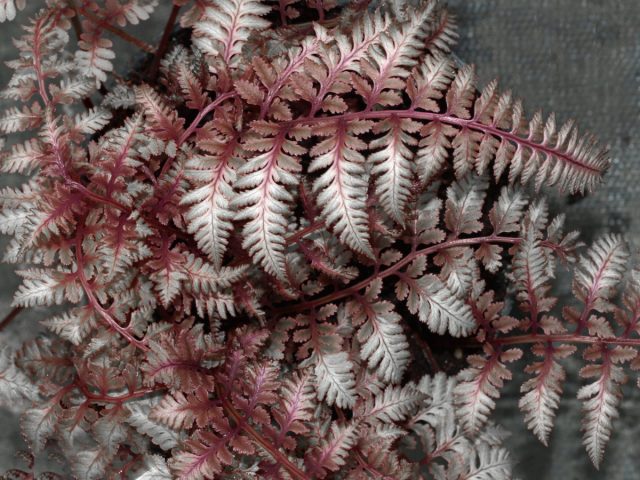
The foliage of the Japanese lady’s fern variety ‘Ursula’s Red’ (Athyrium niponicum ‘Ursula’s Red’) is also silvery-green, with a wide purple stripe running down the center of the leaf and pink-purple veins. Height: up to 50 cm.
Also worth noting is the pictum variation with silvery-grey-green leaves with a metallic sheen and purple-red tones on the stem. Maximum height is 40 cm.
Geiger (Heuchera)
Here is another plant, without which it is difficult to imagine a decorative foliage mixborder. Heuchera has a clear hemispherical habitus and graceful leaves of all possible colors. In addition, many varieties bloom abundantly and effectively.
In terms of the number of cultivars, it can compete with the hosta and is suitable for creating a collection – heucheraria. In the design, heuchera blood-red, small-flowered, shaking and hybrid are used, the latter is distinguished by the greatest variety of decorative forms.
Heuchera hybrid prefers sunny places, but tolerates partial shade (except for brightly colored varieties). The soil should be fertile and well-drained. In general, the plant is unpretentious, winter-hardy and is not affected by pests and diseases. It needs mandatory hilling for the winter, because the rhizomes stick out of the ground, forming a hummock. It grows in one place without losing its decorative effect from 3 to 6 years.
“Amber Waves”
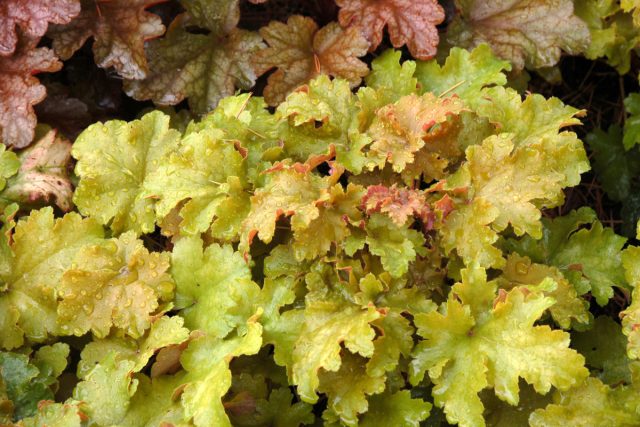
Heuchera ‘Amber Waves’ has bright yellow-orange leaves, golden when young, fading to light green in the shade, the underside of the leaf is light purple. It blooms with light pink lacy panicles in July-August, after flowering it forms a bush 20 cm high and 30 cm in diameter.
“Beauty Color”
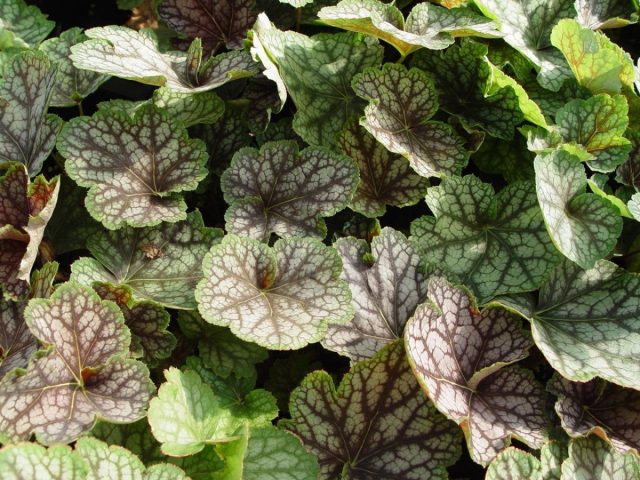
The variety “Beauty Color” (Heuchera ‘Beauty Color’) has velvety leaves with pronounced venation, young ones are red-brown with a light green edge, during the season they become green with red-brown veins, and in autumn they acquire a bright coral border. It blooms in June-August with pink panicles up to 60 cm, after flowering the bush is 30×30 cm.
Autumn Leafs
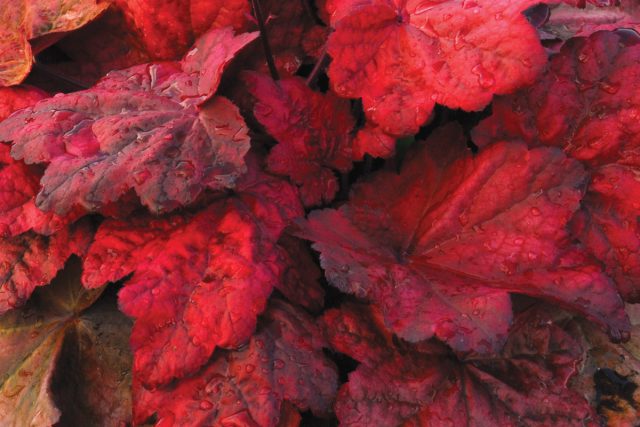
Heuchera ‘Autumn Leaves’ has unique, slightly crumpled leaves. In spring they are pale orange, but by summer they become brighter and acquire red tones, and in autumn they darken to a burgundy shade. It blooms in June-August with white panicles up to 60 cm, after flowering the bush is 30×30 cm.
“Cascade Dawn”
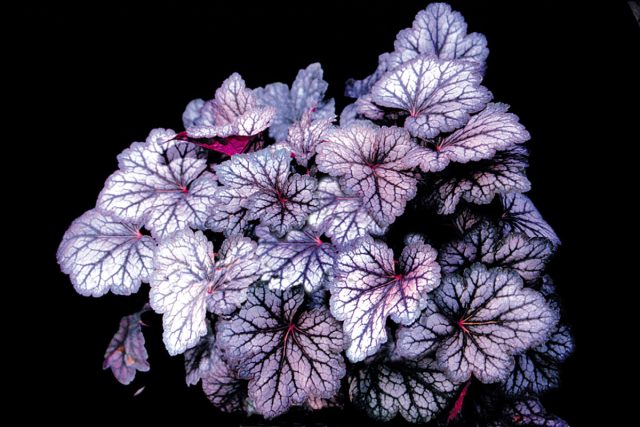
Heuchera x hybrida ‘Cascade Dawn’ stands out with silvery-grey foliage with dark veins and a purple underside. It reaches 40 cm in flowering, the leaf cushion is half as low. It blooms with greenish-white panicles in July.
«Georgia Peach»
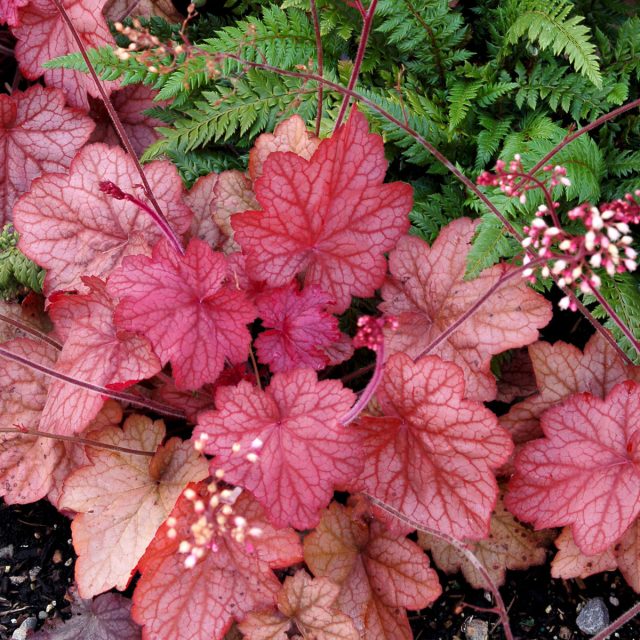
The Georgia Peach variety (Heuchera ‘Georgia Peach’) has large peachy-pink leaves with bright veins, the reverse side is raspberry. It blooms with creamy-white flowers on burgundy peduncles 50 cm high in June-July. After flowering, it forms a bush 30×30 cm.
“Magic Colors”
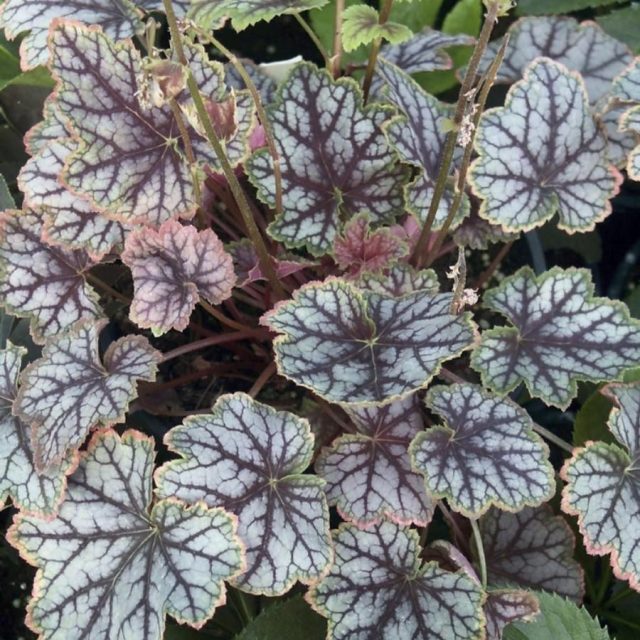
Heuchera ‘Magic Color’ changes color throughout the season: young leaves are bright green with red veins and a golden edge, later – silvery with raspberry-violet veins and a green border. One of the earliest flowering varieties: it blooms in May-July, after which the bush size is 30×30 cm.
“Forever Purple”
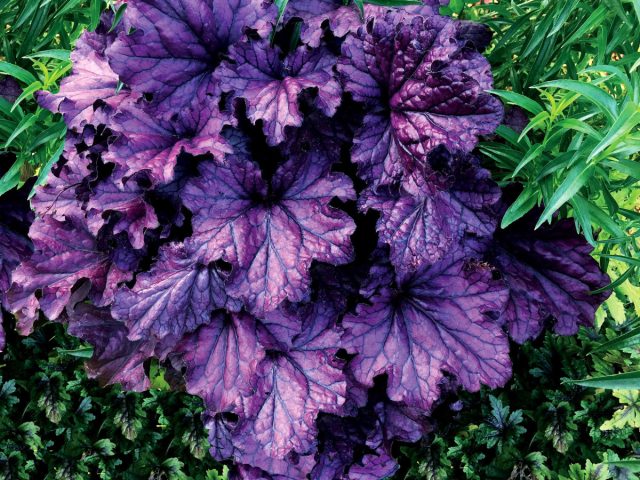
Heuchera ‘Forever Purple’ has beet-purple foliage with dark purple-blue veins and a dark crimson underside. It blooms in July-August with small pink flowers. It forms a hemispherical bush 30 cm high and 50 cm in diameter.
“Shuga Frosting”
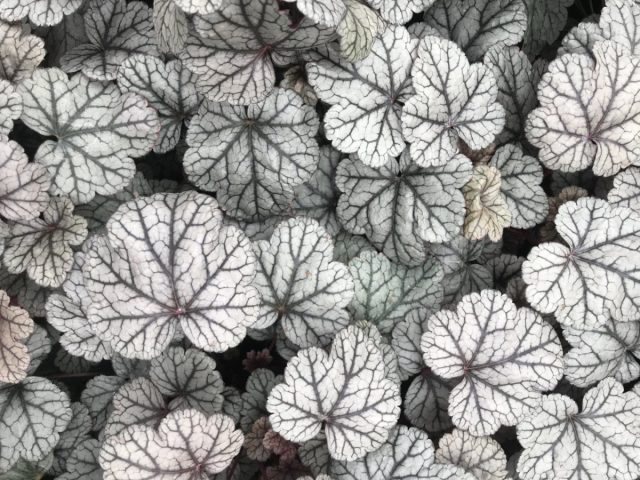
Compact variety of Heuchera “Sugar Frosting” – a spherical bush 20 cm in diameter. Leaves are purple-burgundy with dark veins and a gray-metallic coating. Blooms with cream flowers in June-July.
“Electric Lime”
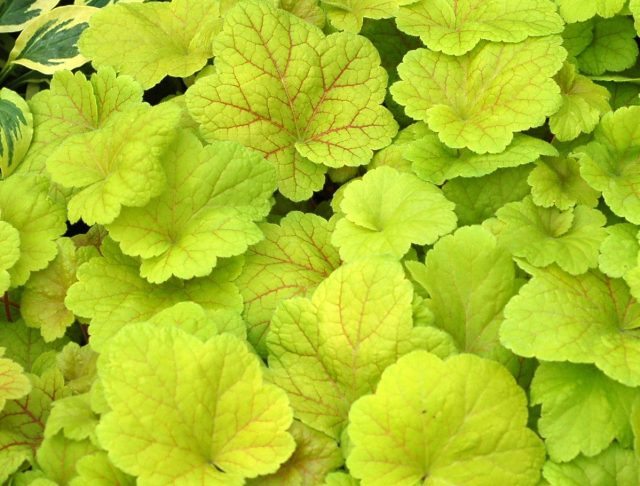
The leaves of the Heuchera ‘Electric Lime’ variety are large, pubescent, rich lemon-colored, and turn lime-colored with red veins by autumn. Another early-flowering variety: it blooms with white panicles in May-June. After flowering, it is a 35×35 cm bush.
It is also worth paying attention to the heucherella, a close relative of the hybrid heuchera, obtained from crossing with the cordifolia tiarella, and its varieties. Heucherella has similar agricultural technology, habitus and leaf shape, but the inflorescences are more similar to the brushes of the tiarella.
Brunnera or forget-me-not (Brunnera)
In landscape design, the species Brunnera sibirica and Brunnera macrophylla are used, among the varieties of which there are many variegated forms.
Brunnera macrophylla tolerates strong shading and develops well even under the crowns of mature trees. Growing in the sun is possible only with abundant watering.
Prefers moist clay soils of medium fertility. It can grow in one place for up to 10 years. Brunnera blooms in spring with small blue flowers reminiscent of forget-me-nots. The rest of the season, it decorates the garden with large heart-shaped leaves. It is important to remember that by mid-to-late summer, the foliage dries out, but after pruning and with proper watering, it grows back.
“Hadspen Cream”
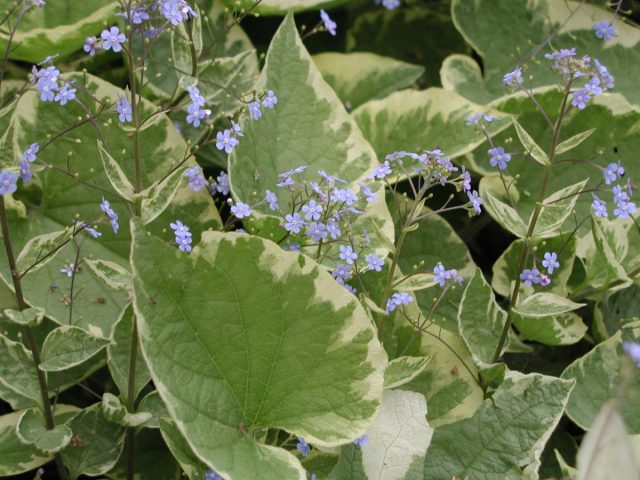
The cultivar ‘Hadspen Cream’ (Brunnera macrophylla ‘Hadspen Cream’) has green leaves with a wide, uneven cream-coloured border that turns white with age. It blooms in May-June. It forms a 30 cm high ground cover.
“Looking Glass”
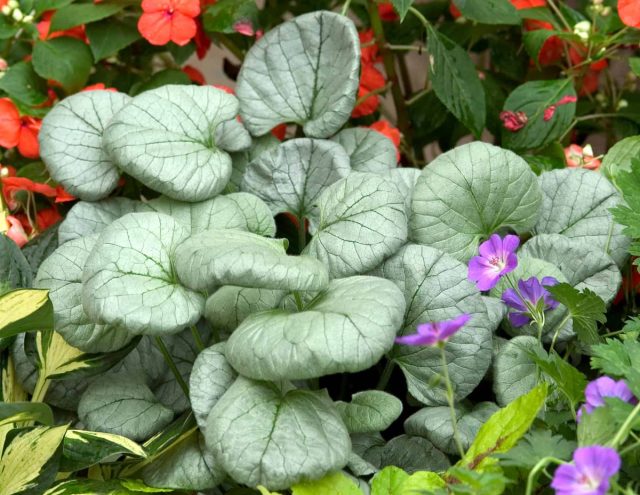
The cultivar ‘Looking Glass’ (Brunnera macrophylla ‘Looking Glass’) has silvery foliage with dark veins. It blooms in May-June. It reaches a height of 35 cm.
“Silver Wings”
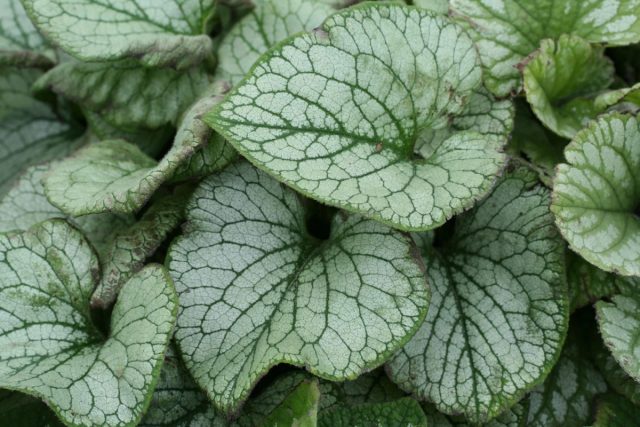
Brunnera macrophylla ‘Silver Wings’ has large green leaves with regular silver spots. Flowering occurs in April-May. Height – 30 cm.
“Mr. Morse”
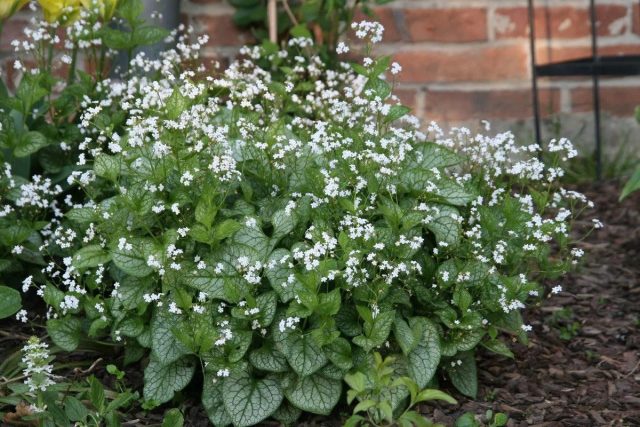
The cultivar ‘Mr. Morse’ (Brunnera macrophylla ‘Mr. Morse’) stands out among other cultivars with its creamy white flowers that bloom in April-May. The leaves are large, silvery, with light green veins and edges. Height – 30 cm.
“Variegata”
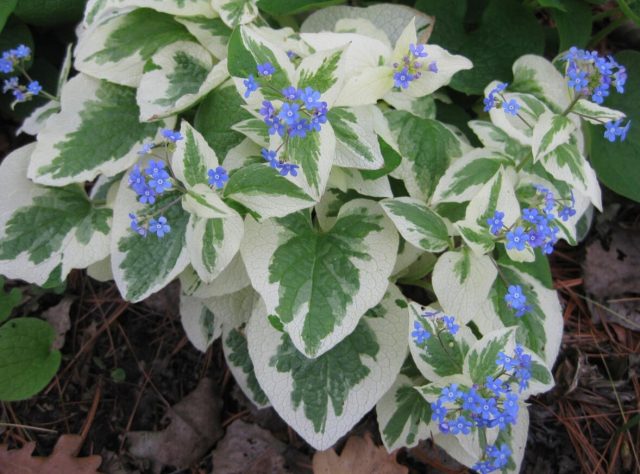
Another spectacular variety of Brunnera is ‘Variegata’. The foliage has a wide creamy-white border, with long tongues extending onto the leaf blade. Flowering period is May-June. Height is up to 30 cm.






